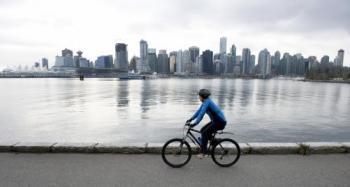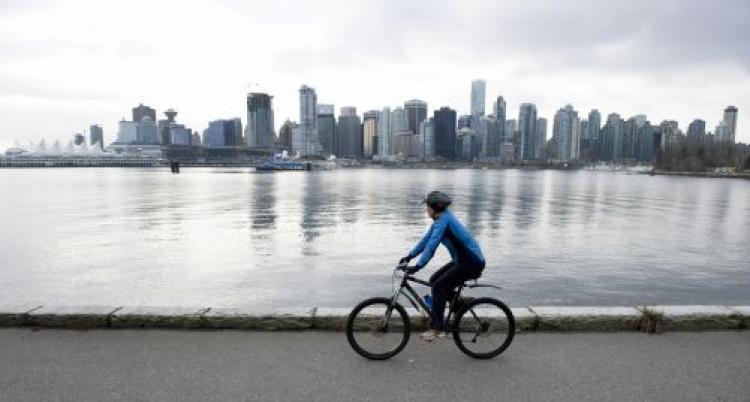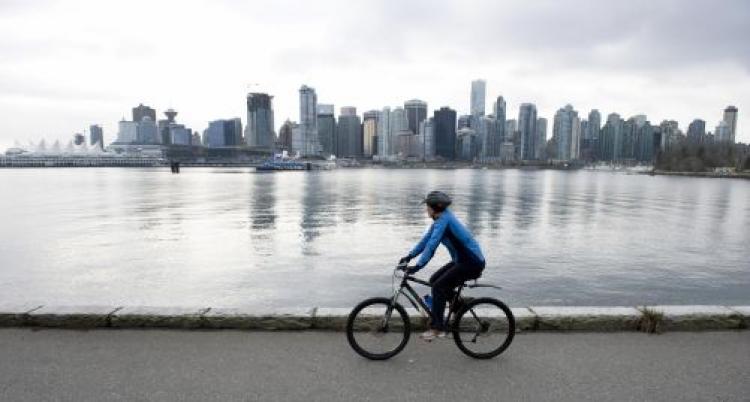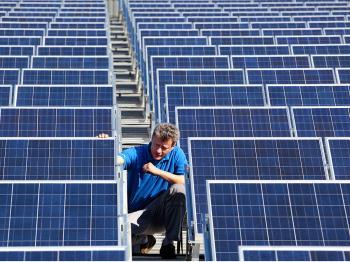Gone are the days when people could make an honest living, purchase, build, make, or grow whatever they needed—and do all that within the boundaries of their own communities.
It seems that nowadays almost everyone finds themselves having to travel great distances for a variety of reasons. Some travel everyday to and from work, many children travel beyond walking distance to school, we travel around in search of things to do and things to buy that are unavailable near us.
At the same time, many of the ways we use to get from point A to point B require the consumption of resources. As a society, we have come to realize that all this traveling around by so many people is taking its toll on the environment. It also seems that it is our human nature to try and “have our cake and eat it too.”
So how can we continue to get to where we need to go, obtain the items we need to live, do the things we like to do, and not leave a huge carbon footprint on the planet at the same time?
Many may argue that it is their civil liberty to come and go as they please. Although there are some who may argue against this point, if you are taking steps to live green, you probably already understand that living green is not about giving up all of life’s comforts. You probably already realize that there may be some self-sacrifice involved, but it’s mainly about wise decision-making and adjusting your lifestyle in such a way that your actions are not environmentally destructive while you’re living a normal life in modern society.
One of the first things you can do is simply travel less. This can be looked at from two angles. You can begin by assessing your needs and wants.
We have become a society that revolves around impulse buying and immediate gratification. As far as traveling is concerned, this manifests as running right out and buying just about whatever comes to mind as soon as it comes to mind. Sometimes, we don’t take that extra second to ask ourselves if it’s something we really need or just something we really want.
If you can get into the habit of going out only when you need to rather than every time you want to, you will decrease the size of your carbon footprint and you’ll probably save money over time too. So, the first step is to sit down with yourself and brainstorm a list of all the reasons you leave the house and categorize them into needs and wants.
Some common needs include work, school, grocery shopping, taking family members to the doctor, and so on. Some common wants include trips to malls, restaurants, going out to the movies, and the like. Once you’ve done this, the next step is easy: Whenever possible or feasible, try to consolidate all of your needs and wants into the same trip. For example, stop at the grocery store on the way home from work.
The way we get around is another factor that contributes to the environmental impact of our traveling. Everyone knows that the two most environmentally friendly ways of traveling are by foot (walking or jogging) or by using a human-powered machine like a bicycle, scooter, skateboard, or rollerblades. In modern times, however, many of our needs are not easily met by using these two methods.
When these two modes of travel are not practical because of the weather or because you’re running late, for example, your other green options are to use public transportation such as the bus or train, or carpool. Commuter trains tend to run on electricity, so they are probably the best option if they are available. Using buses or carpooling still involves using a fuel-burning vehicle. Although it is still damaging to a certain degree, it would be the next best option due to its consolidating effect.
If it is within your financial means, there are still more options for you as to method of transportation. For example, you could purchase an electric-powered vehicle such as an electric car, bike, or scooter. An acceptable but somewhat less green option would be buying a hybrid car, an alternative fuel-burning car, or simply a fuel-efficient car. Any of these options are good. The fewer resources they consume or the less fuel they burn makes them better.
Besides assessing your needs and wants, consolidating your traveling, and considering your mode or travel, another thing to look at is the distance you travel. The closer you can stay to home, the less impact you will cause to the environment when you do go out. Basically, this means shop locally, buy locally produced goods, try to live as close to your job as possible, and send your kids to school as close to home as possible.
Some of these ideas are simply not feasible or practical for many families because the way things are set up nowadays doesn’t allow us to do this easily. For many people, jobs close to home would not support their lifestyles, or homes close to their jobs are too expensive.
There are still other options. Maybe you have to commute to work. It is very common in places like Japan for suburbanites to walk or bike to the train station, where they then take the train to a large metropolitan area where they work. They may live far away from their jobs, but they’ve used human-powered transportation to get part of the way and electric mass-transit to take them the rest of the way.
So you can see, there are many options to consider when assessing how you can travel “green.” It’s really about wise decision-making and replacing old habits with eco-friendly ones. As the demand for more green modes of getting to the places we want or need to get to increase, we may find that industry and government might start making many of these decisions more convenient.
It seems that nowadays almost everyone finds themselves having to travel great distances for a variety of reasons. Some travel everyday to and from work, many children travel beyond walking distance to school, we travel around in search of things to do and things to buy that are unavailable near us.
At the same time, many of the ways we use to get from point A to point B require the consumption of resources. As a society, we have come to realize that all this traveling around by so many people is taking its toll on the environment. It also seems that it is our human nature to try and “have our cake and eat it too.”
So how can we continue to get to where we need to go, obtain the items we need to live, do the things we like to do, and not leave a huge carbon footprint on the planet at the same time?
Many may argue that it is their civil liberty to come and go as they please. Although there are some who may argue against this point, if you are taking steps to live green, you probably already understand that living green is not about giving up all of life’s comforts. You probably already realize that there may be some self-sacrifice involved, but it’s mainly about wise decision-making and adjusting your lifestyle in such a way that your actions are not environmentally destructive while you’re living a normal life in modern society.
One of the first things you can do is simply travel less. This can be looked at from two angles. You can begin by assessing your needs and wants.
We have become a society that revolves around impulse buying and immediate gratification. As far as traveling is concerned, this manifests as running right out and buying just about whatever comes to mind as soon as it comes to mind. Sometimes, we don’t take that extra second to ask ourselves if it’s something we really need or just something we really want.
If you can get into the habit of going out only when you need to rather than every time you want to, you will decrease the size of your carbon footprint and you’ll probably save money over time too. So, the first step is to sit down with yourself and brainstorm a list of all the reasons you leave the house and categorize them into needs and wants.
Some common needs include work, school, grocery shopping, taking family members to the doctor, and so on. Some common wants include trips to malls, restaurants, going out to the movies, and the like. Once you’ve done this, the next step is easy: Whenever possible or feasible, try to consolidate all of your needs and wants into the same trip. For example, stop at the grocery store on the way home from work.
The way we get around is another factor that contributes to the environmental impact of our traveling. Everyone knows that the two most environmentally friendly ways of traveling are by foot (walking or jogging) or by using a human-powered machine like a bicycle, scooter, skateboard, or rollerblades. In modern times, however, many of our needs are not easily met by using these two methods.
When these two modes of travel are not practical because of the weather or because you’re running late, for example, your other green options are to use public transportation such as the bus or train, or carpool. Commuter trains tend to run on electricity, so they are probably the best option if they are available. Using buses or carpooling still involves using a fuel-burning vehicle. Although it is still damaging to a certain degree, it would be the next best option due to its consolidating effect.
If it is within your financial means, there are still more options for you as to method of transportation. For example, you could purchase an electric-powered vehicle such as an electric car, bike, or scooter. An acceptable but somewhat less green option would be buying a hybrid car, an alternative fuel-burning car, or simply a fuel-efficient car. Any of these options are good. The fewer resources they consume or the less fuel they burn makes them better.
Besides assessing your needs and wants, consolidating your traveling, and considering your mode or travel, another thing to look at is the distance you travel. The closer you can stay to home, the less impact you will cause to the environment when you do go out. Basically, this means shop locally, buy locally produced goods, try to live as close to your job as possible, and send your kids to school as close to home as possible.
Some of these ideas are simply not feasible or practical for many families because the way things are set up nowadays doesn’t allow us to do this easily. For many people, jobs close to home would not support their lifestyles, or homes close to their jobs are too expensive.
There are still other options. Maybe you have to commute to work. It is very common in places like Japan for suburbanites to walk or bike to the train station, where they then take the train to a large metropolitan area where they work. They may live far away from their jobs, but they’ve used human-powered transportation to get part of the way and electric mass-transit to take them the rest of the way.
So you can see, there are many options to consider when assessing how you can travel “green.” It’s really about wise decision-making and replacing old habits with eco-friendly ones. As the demand for more green modes of getting to the places we want or need to get to increase, we may find that industry and government might start making many of these decisions more convenient.






